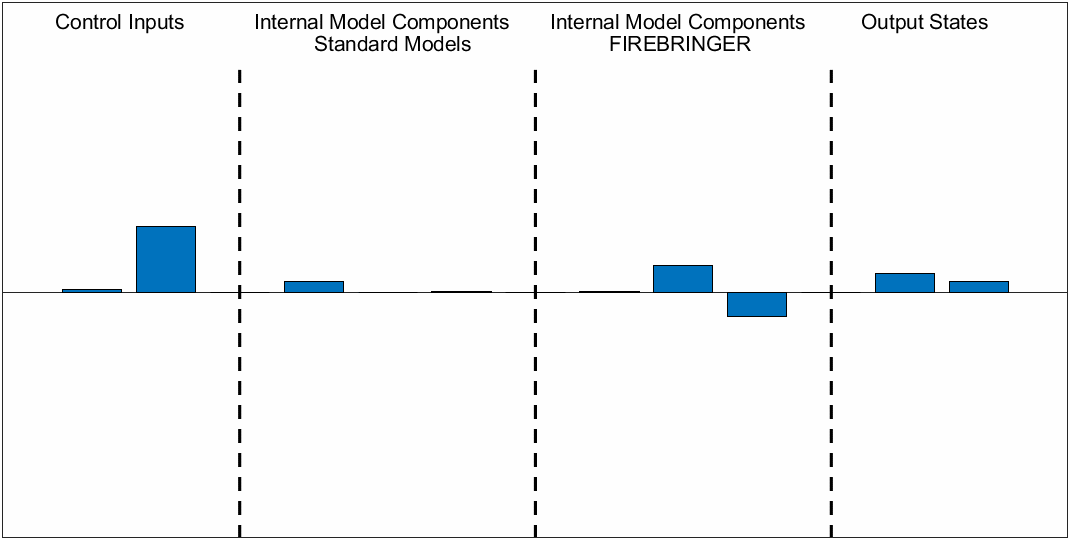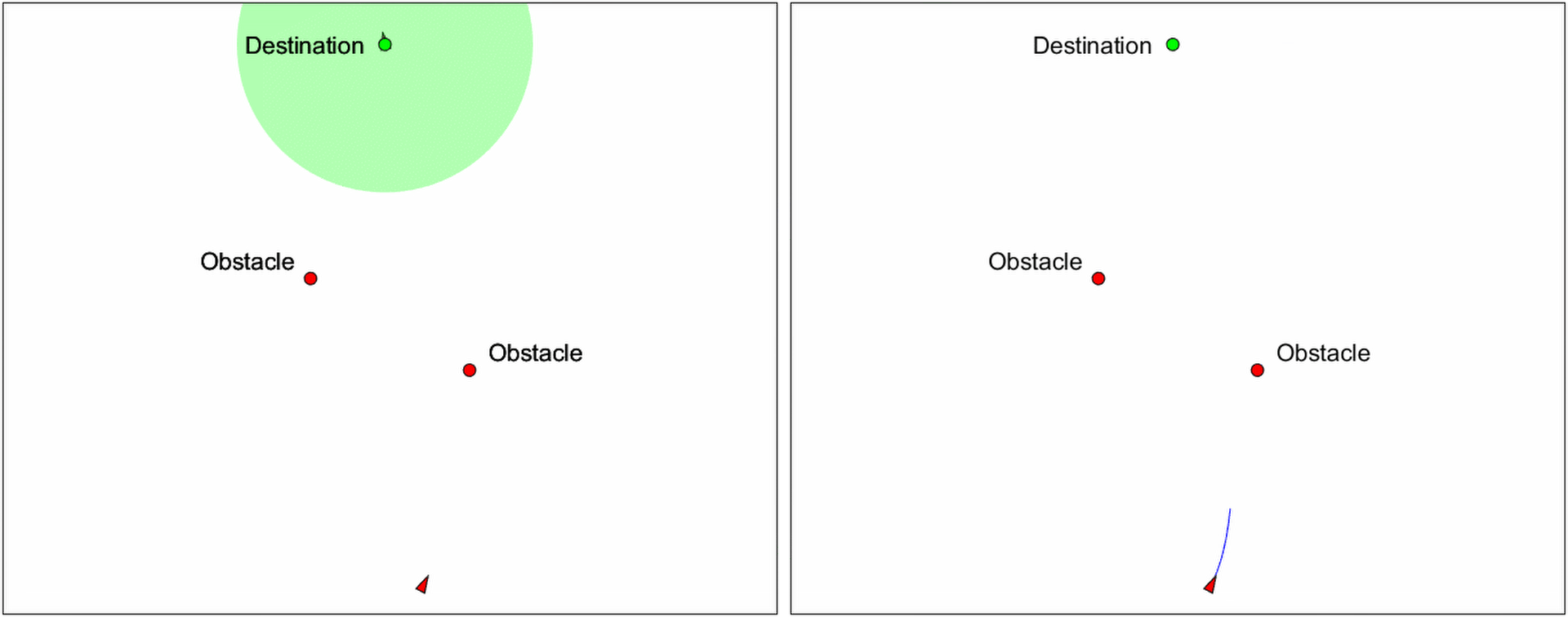The FIREBRINGER controller was created to address some of the major limitations that currently exist in State-of-the-Art robotic motion controllers that prevent them from being properly utilized in specialized areas like maritime and swarm robotics. The overarching aim of FIREBRINGER is to enable advanced autonomous control in these specialized areas through integration with other State-of-the-Art robotic techniques (e.g., SLAM) – a feature that is not currently offered at a satisfactory level by existing technologies.
Control Scheme #
In autonomous robotic navigation, failure states are scenarios where a vehicle becomes “trapped” and unable to maneuver out of its position due to its motion constraints and the surrounding environment. This is particularly relevant for vehicles with limited maneuverability, such as vessels with a restricted turning radius, which cannot change their orientation or direction of travel as freely as omnidirectional robots or vehicles capable of rotating in place. In maritime robotics, autonomous navigation often takes place in open environments like the ocean, where obstacles are generally sparse. However, even in such settings, complex and dynamic environments emerge near harbors, narrow channels, or in the presence of other moving vessels. Unlike land-based robots that can rely on simpler reactive control strategies due to their higher motion flexibility, maritime robots require more sophisticated approaches to account for their dynamics and environmental interactions.
Advanced control schemes like Model Predictive Control (MPC) are critical in such contexts as they enable the prediction of future states over a finite horizon. MPC computes optimal control inputs by considering constraints such as the vehicle’s maximum speed, acceleration, turning radius, and proximity to obstacles. This predictive capability allows the system to avoid configurations that might lead to failure states, ensuring safe navigation even in complex scenarios. Nevertheless, State-of-the-Art MPC implementations present several challenges when utilized for maritime robotic applications, primarily due to the inherent complexity that emerges when trying to describe the motion of such vehicles. The rest of this page will delve deeper into these challenges, while explaining how they are addressed by the FIREBRINGER implementation.
Motion Model Complexity vs Output Behavior Predictability #
State-of-the-Art Model Predictive Control (MPC) schemes are designed to achieve optimal navigation behavior by determining the ideal control inputs, such as thrust or steering angles, based on a predictive model of the system’s motion. In fields like maritime robotics, motion models are particularly complex because they account for hydrodynamic effects, such as drag, added mass, wave forces, and other fluid-structure interactions. These effects introduce additional terms and nonlinearities into the modelling equations, complicating the model’s structure.
The inherent complexity of traditional aquatic motion models stems from the detailed representation of hydrodynamic forces. However, these constraints generally result in a simpler overall system response, as hydrodynamic effects will typically slow down the vehicle’s reaction to control inputs. This paradox—where complex models describe slow and relatively predictable behaviors—introduces significant challenges for the computational performance of MPC. Specifically:
- Smaller Timestep Sizes: The hydrodynamic models require smaller timesteps to ensure numerical stability of predictions, compared to standard kinematic models employed by ground vehicles.
- Larger Prediction Horizons: Due to the slower response of the system, the MPC must predict further into the future to capture meaningful behavior and ensure effective navigation planning. This extended prediction horizon is necessary to provide the controller with enough information to anticipate and avoid potential constraints or failure states.
Together, these requirements increase the number of discrete steps in the MPC prediction horizon. This leads to a substantial rise in computational complexity, requiring significant resources to handle the large number of decision variables and constraints. This can compromise the controller’s real-time computational speed, limiting its usability in fast-changing environments or on hardware with constrained processing power.
The FIREBRINGER algorithm addresses the hydrodynamic modelling paradox by simplifying the representation of vehicle dynamics while still accurately capturing the key behavioral outcomes. In this way, it allows for larger timestep sizes without compromising MPC stability. By focusing on capturing the system’s resultant simple behaviors rather than its internal complexities, FIREBRINGER enables a faster and more efficient MPC implementation, offering a balance between accuracy and computational feasibility and making advanced control more practical for real-time maritime robotic applications.

Core Concept #
The core innovation of the FIREBRINGER algorithm lies in its use of artificial potential field theory to represent the motion of a vehicle. Rather than relying on a detailed motion model that includes all hydrodynamic forces and their nonlinear interactions, FIREBRINGER abstracts the vehicle’s behavior into a system influenced by virtual forces. These forces are categorized as repulsive forces, which prevent collisions by pushing the vehicle away from obstacles, and attractive forces, which pull the vehicle towards a target or along a desired trajectory.
To ensure that the virtual forces translate into physically feasible motion, the FIREBRINGER algorithm incorporates the vehicle’s motion limitations—such as maximum velocity and maximum acceleration for each degree of freedom (DoF)—into the linear system that relates the forces to the vehicle’s state outputs. This guarantees that the modelled behavior is always achievable by the real system, eliminating scenarios where the control scheme proposes behaviors beyond the vehicle’s capabilities.
Unlike traditional MPC schemes, which compute optimal actuation efforts to achieve desired motion, the FIREBRINGER algorithm operates at a higher level of abstraction, by optimizing the intensities of the artificial potential fields to produce the desired behavior. Once the optimal field intensities are determined for a specific timestep, they are translated into the corresponding actuation efforts required to achieve the optimal motion. This two-step process simplifies the computational demands of the control problem, as the optimization is performed over a smaller and less complex parameter space.

Enhanced Controller Robustness #
To enhance computational performance, standard MPC schemes often utilize the optimal control sequence from the previous timestep as the initial condition for the current optimization process. This approach operates on the assumption that the optimal control sequence will not vary significantly between timesteps, allowing the algorithm to converge more quickly by reducing the number of optimization steps. While this methodology can greatly improve computational speed, it introduces a dependency on the stability of previous optimizations. If a single optimization process fails or becomes unstable, the resulting errors can cascade into subsequent iterations, potentially leading to the overall failure of the control algorithm.
Failure detection mechanisms are commonly employed to mitigate this risk by identifying unstable optimizations and re-initializing the control process. However, these mechanisms are not foolproof. They may fail to detect instability quickly enough, allowing errors to propagate, or may require significant time for the algorithm to recover and generate a sufficiently close-to-optimal control sequence. Furthermore, in dynamic environments, where the system’s control requirements can change rapidly, the assumption that the previous optimal control sequence is close to the new one often breaks down, negating the computational advantages of this methodology.
The FIREBRINGER algorithm addresses these challenges by adopting a fundamentally different approach to initialization. Instead of relying on the previous timestep’s solution, FIREBRINGER leverages predefined heuristic equations commonly used in artificial potential field theory. These equations, often based on distance-dependent relationships, can provide an initial estimate of the intensity of each artificial potential field. While heuristic equations may not produce fully optimal results, they are capable of generating close-to-optimal behaviors without extensive computational effort.
FIREBRINGER uses these heuristic-derived field intensities as the initial conditions for each MPC optimization process. This ensures that each optimization process is independent of the previous one, eliminating the risk of cascading errors from unstable iterations. Moreover, the initial conditions derived from the heuristic equations are already close to the desired behavior, allowing the MPC to refine and optimize the control inputs quickly and efficiently.




